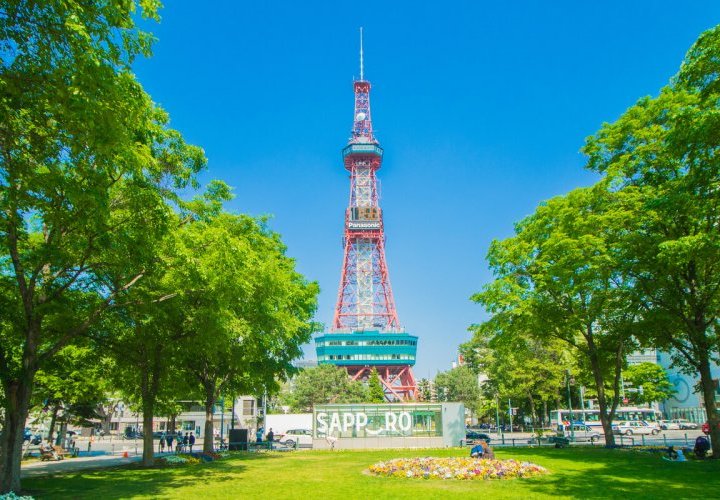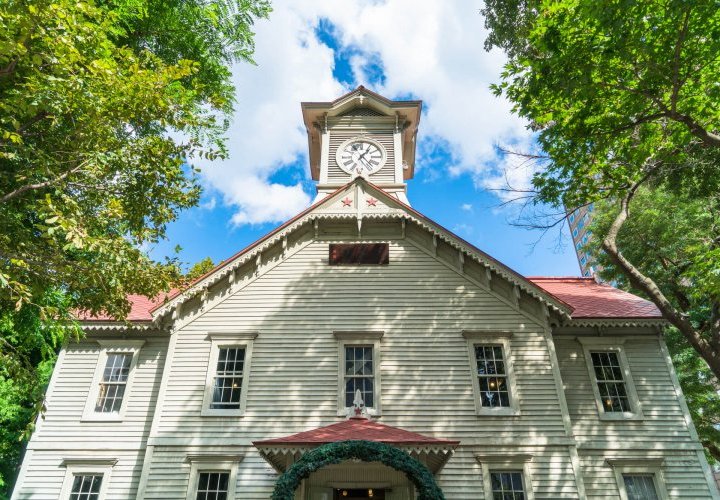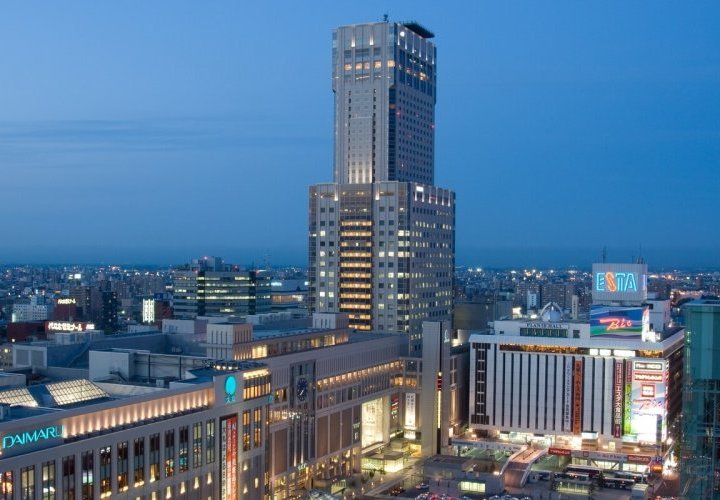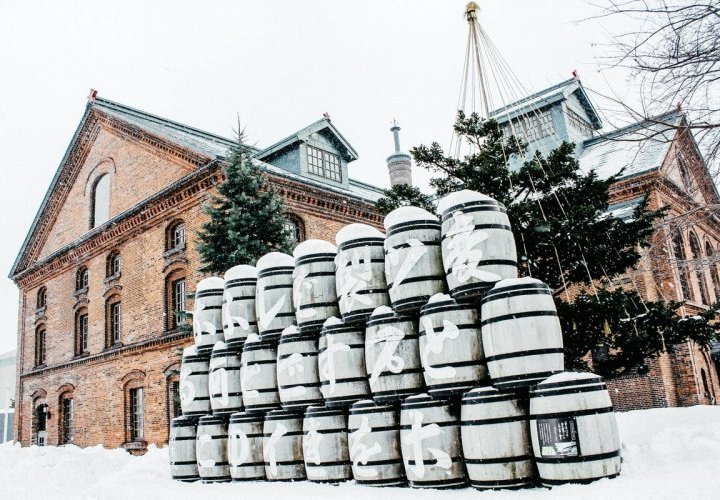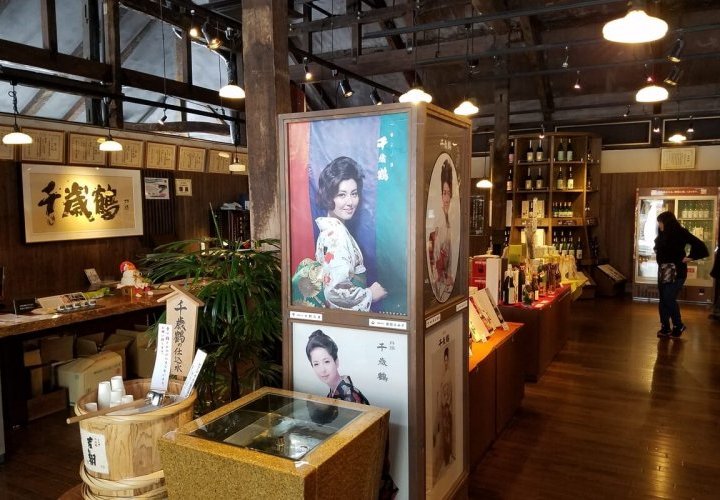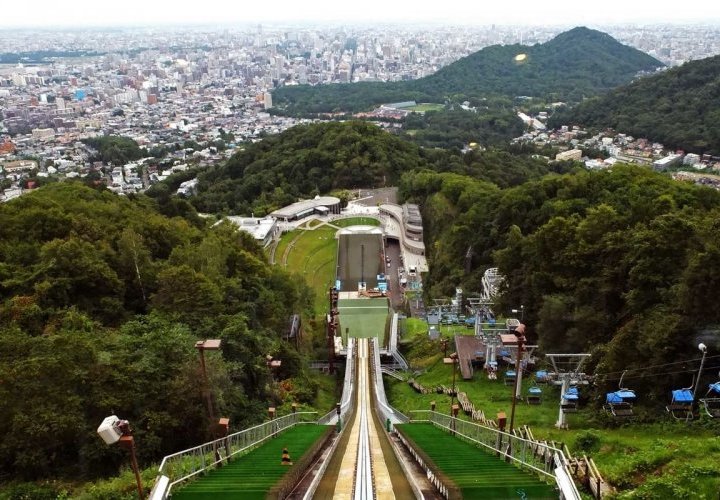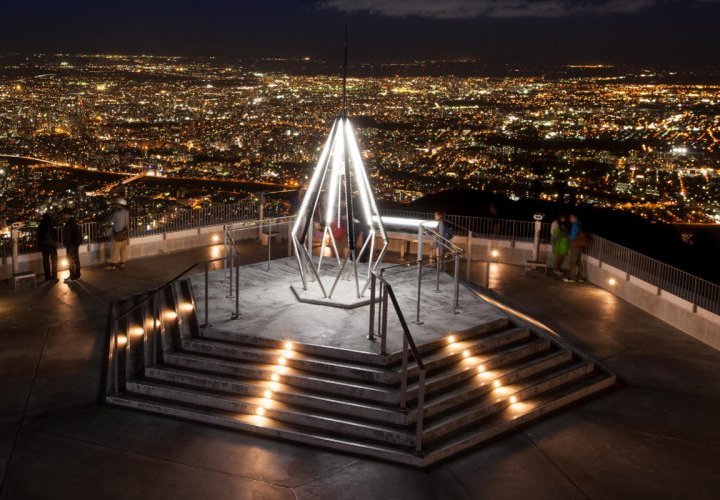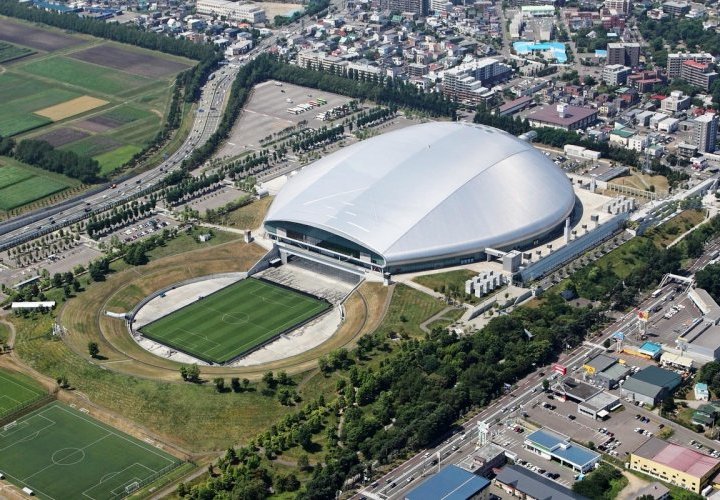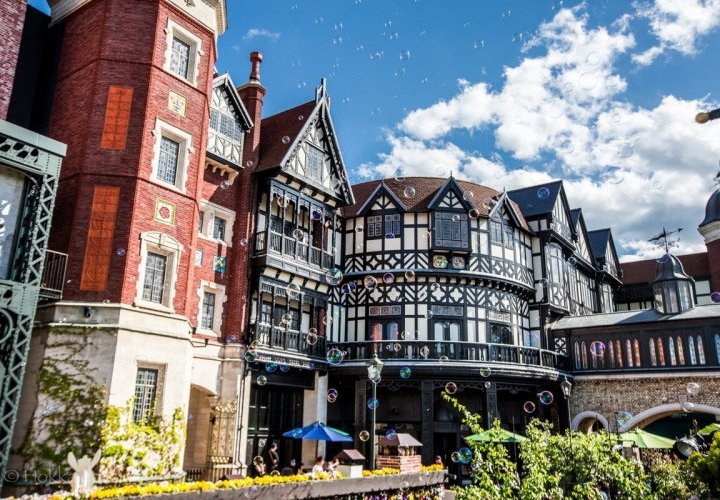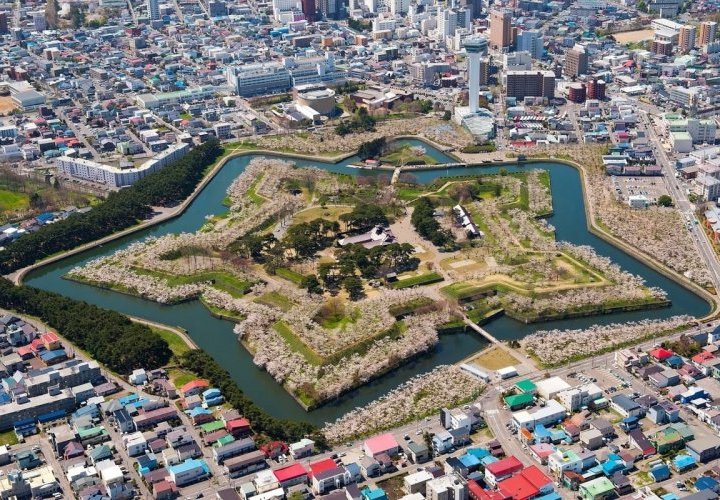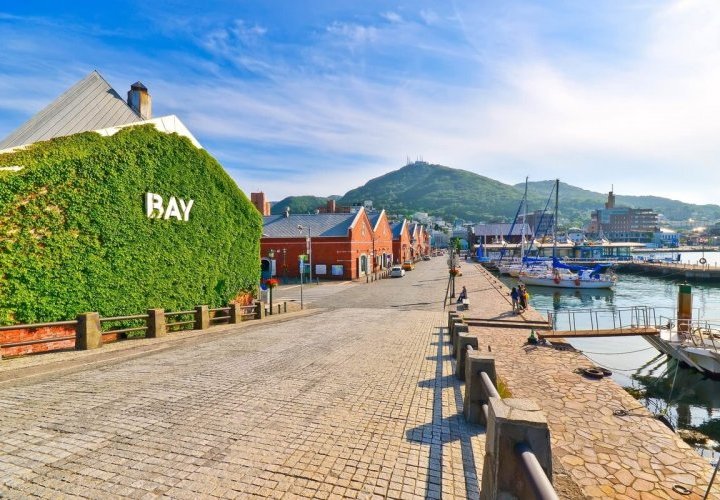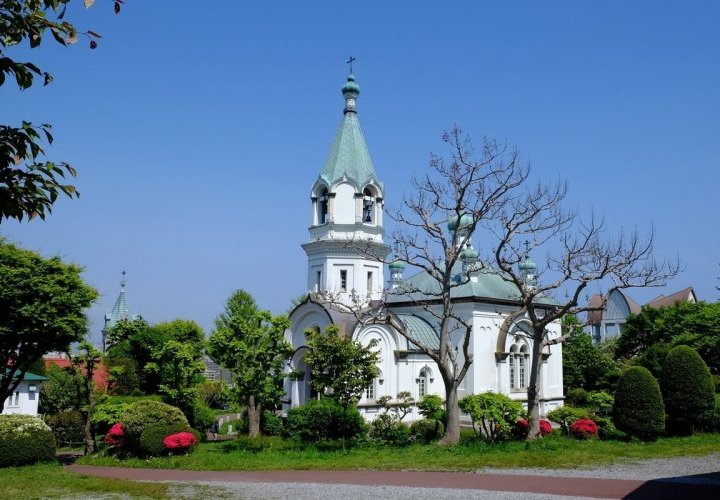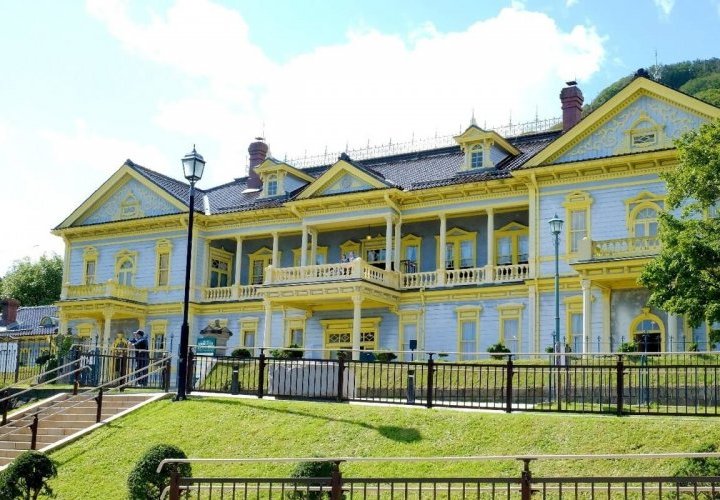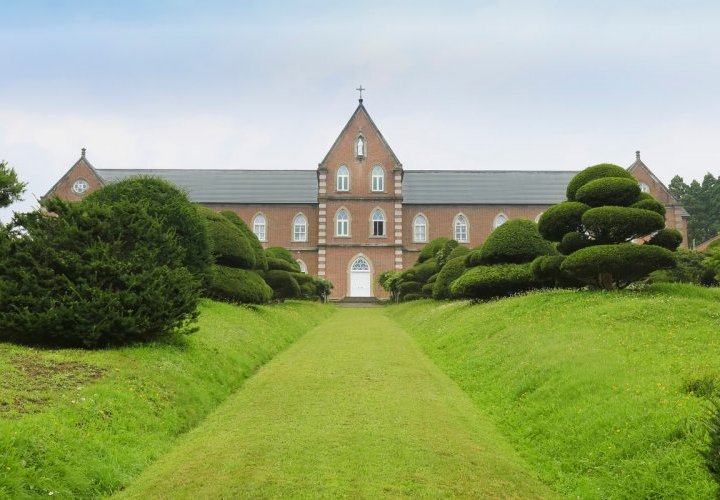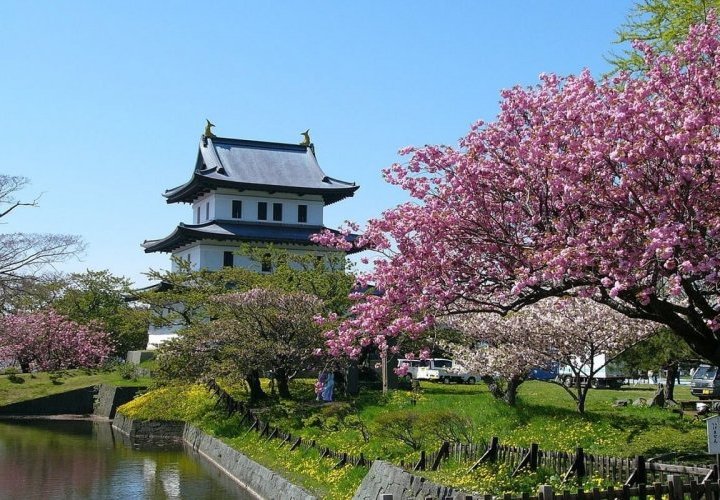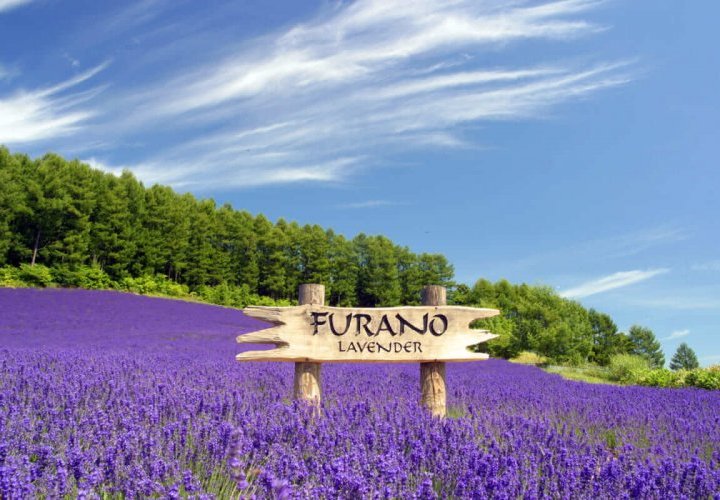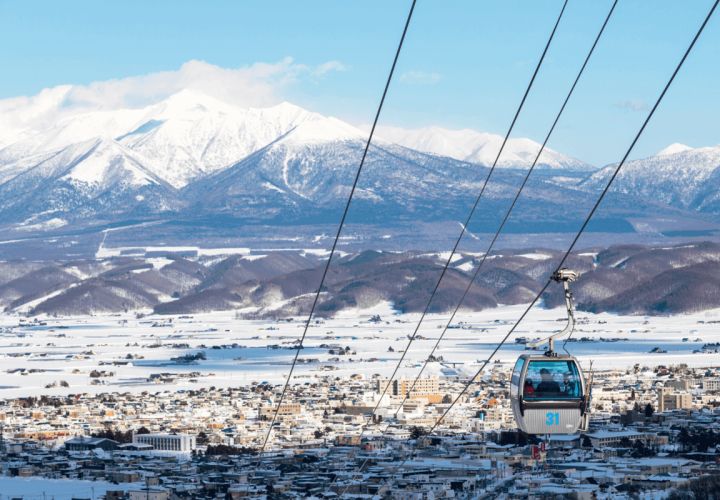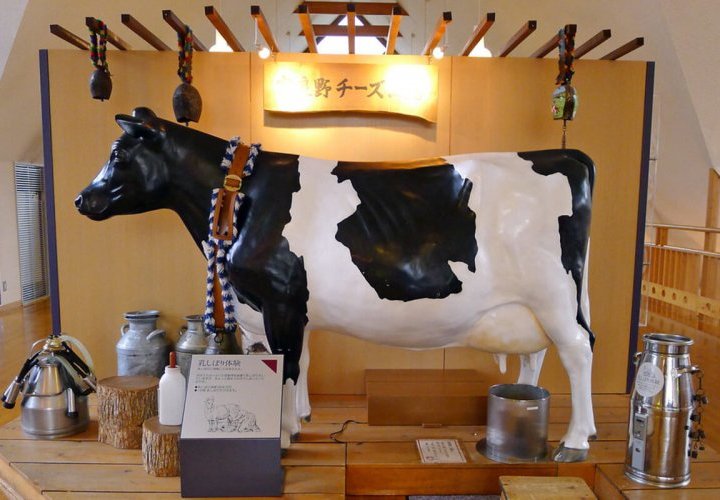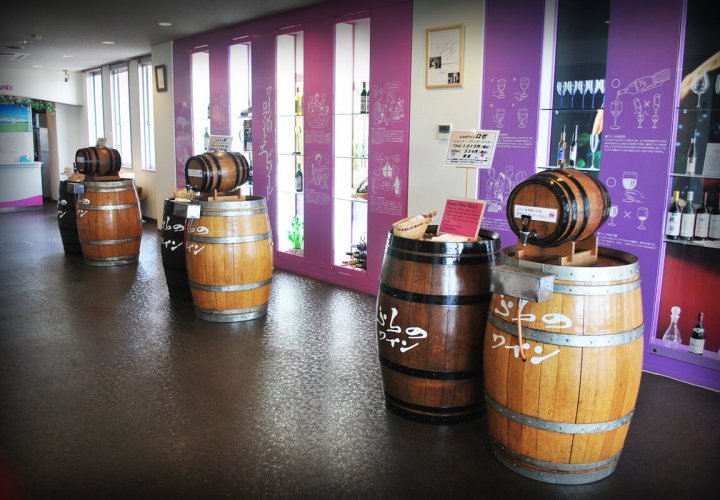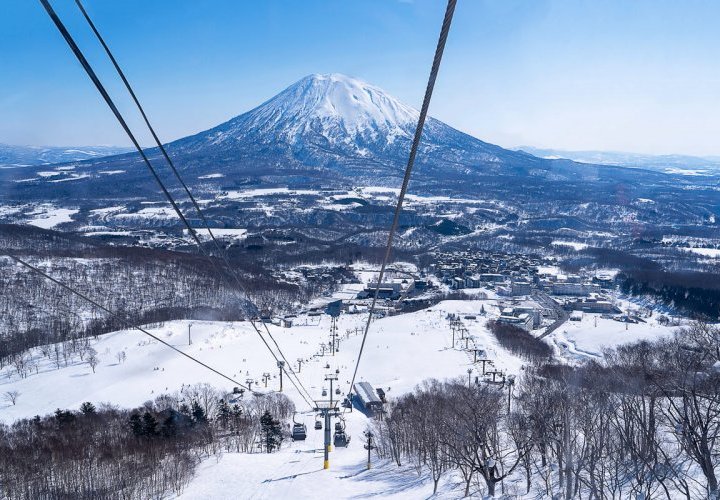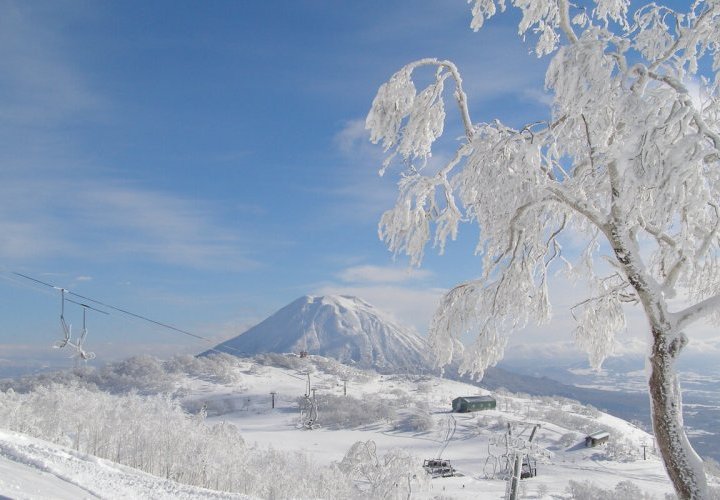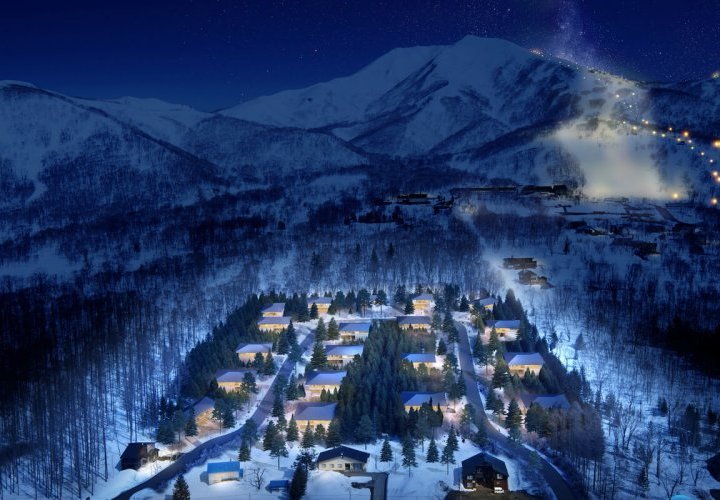The unspoiled nature of Hokkaido attracts many outdoor lovers, including snowboarders and skiers in winter and hikers, campers and cyclists in summer. Situated in the northern limit of the temperate regions and the southern limit of the subarctic zones, it has 4 distinctive seasons and is characterized by a cool climate which is unique compared with the rest of Japan. The summer is comfortable, as it does not get as hot and humid as in the other parts of the country. The average temperature from June to August is between 15 and 26 °C. Since it’s cool in the morning, visitors are encouraged to pack light jackets in addition to their summer clothes. In winter the freezing temperatures continue over an extended period in many regions. There is a lot of snowfall, below zero temperatures and frozen seas in winter in Hokkaido. The average temperature from December to March is between -12 and 3 °C. more
Since roads and sidewalks become slippery, people are recommended to attach anti-slip gear to their shoes. If you plan your trip in winter, you should take into account the fact that sunset hours are much earlier and it gets dark at around 16:30.
Located in the northwestern part of the Ishikari Plain, Sapporo is the capital of Hokkaido and the largest city on the island. It is the largest city of Hokkaido with a population of over 1.89 million and plays a central role in administration, transportation and economy of the island. However, it’s one of Japan’s youngest cities becoming world famous in 1972 when the Winter Olympic Games were held there. Sapporo is a popular tourist spot famous for its ramen, beer and in particular, the Snow Festival that attracts a great number of tourists from the rest of the country, as well as from abroad.
TOURIST ATTRACTIONS IN SAPPORO
Sapporo TV Tower
This is Sapporo’s landmark, located in Odori Park. It is 147.2 m high and you can enjoy a 360-degree panoramic view from the observation floor 90 m above the ground.
Clock Tower
The Clock Tower was first built in 1878 as a drill hall of Sapporo Agricultural College and it was transformed into its current structure equipped with a clock in 1881. Inside there is a panel exhibition introducing the history of the Clock Tower.
Odori Park
Odori Park is an oasis in the city centre and extends over 1.5 km from east to west. Decorated with fountains, sculptures and flower beds, the park serves as a site for the Snow Festival in winter and a place for relaxation throughout the year.
Botanical Garden
Opened in 1886, this is Japan’s first modern botanical garden. Approximately 4,000 species of plants grow there.
JR Tower
The view from the JR Tower’s 160 m high observatory (38th floor) is spectacular. The grand scale of Stellar Place Sapporo, shopping and gourmet areas of Daimaru Sapporo, Sapporo Cinema Frontier, JR Tower Hotel Nikko Sapporo and a lot more befits the “new face” of Sapporo.
Hokkaido University
Established as Sapporo Agricultural College in 1876, its expansive, 176-hectare campus is also referred to as the Elm Grove. Hokkaido University serves as a tourist spot with many must-see landmarks, including the Model Barn, an important cultural property, Poplar Avenue and the statue of William S. Clark, who was one of the founders of Sapporo Agricultural College.
Sapporo Beer Museum
Sapporo Beer Museum is the only beer museum in Japan, where the history of Sapporo Beer, established in Hokkaido in 1876 when first brewery was built (Kaitakushi Brewery), is presented. The museum was opened in 1987 in order to provide the visitors a varied knowledge of beer and brewing.
Hokkaido Railway Museum
The building, remodelled from a brick warehouse originally built in 1910, exhibits a large number of railway-related materials. A driving simulator is also popular.
Chitosetsuru Sake Museum
As the only sake brewery in Sapporo, Chitosetsuru presents Chitosetsuru Sake Museum featuring exhibits related to sake and sake culture. Sake tasting and sake-flavoured ice cream are available. You can also visit the galleries and see live performances.
Okurayama Ski Jump Stadium
Okurayama Ski Jump Stadium facilitates winter and summer, both day and night ski jumping. The mountaintop observation lounge allows the visitors to experience a view of Sapporo downtown and Ishikari Plain.
Sapporo Winter Sports Museum
The museum, which exhibits historical materials of winter sports as well as Sapporo Winter Olympic Games is adjacent to Okurayama Ski Jump Stadium. In addition to winter sports related items that are exhibited, ski jump simulations and other activities are available.
Old Hokkaido Government Building
The building, built in 1888, was modelled following the structure of Maryland State House and the Massachusetts State House in the USA. It is an important national cultural property, and the Archives of Hokkaido are housed here along with exhibitions of historical documents.
Mount Moiwa Observatory
The night view from the mountaintop observatory is a must-see. Located at an elevation of 531 m, it allows you to enjoy a 360-degrees view of the city of Sapporo, as well as the Ishikari Plain during daytime. You can take a “stroll in the air” on the ropeway to the top of the mountain.
Susukino
Susukino is the biggest entertainment district north of Tokyo, where approximately 4,500 restaurants and entertainment facilities are crowded together. Many of them remain open after midnight. There are many leading places of interest such as the “Ramen Alley”.
Rose Garden Chizaki
Located in Fushimi, a hill commanding a view of the city, the Rose Garden Chizaki is a rose land where about 4,000 roses of 400 species grow and bloom beautifully.
Hoheikan
Located in Nakajima Park, Hoheikan is an important cultural property recognized by the national government. Built as a Western-style hotel under the direct control of Hokkaido Development Commission (Kaitakushi) in 1880, it displays its ultra-marine blue colour that frames the white external walls.
Sapporo Ainu Culture Promotion Centre
There are exhibits of Ainu lifestyle, history and culture with about 200 restored artefacts. There are also videos on Ainu folklore, an Ainu language quiz and a traditional house (chise) outside.
Sapporo Dome
Sapporo Dome is a stadium primarily used for baseball and football. It serves as the home field of the baseball team Hokkaido Nippon-Ham Fighters and the association football club Hokkaido Consadole Sapporo.
Hitsujigaoka Observation Hill
Hitsujigaoka Observation Hill allows visitors to experience fine views of Sapporo downtown over the green pastures. The place is famous for the statue of Dr. William S. Clark, one of the founders of Sapporo Agricultural College (now Hokkaido University). Another landmark of this tourist spot is the pastoral landscape with grazing sheep.
Shiroi Koibito Park
This dream-like park accommodates the Chocolate Factory where visitors can see how the popular sweet “Shiroi Kobito” is made. In addition to learning the history of chocolate, visitors can enjoy confection-making and cake buffets.
Sapporo Art Park
Sapporo Art Park is an art facility complex where the Outdoor Sculpture Garden, the Indoor Museum of Contemporary Art, the Art Hall and craft studios are located.
Moerenuma Park
The waterside park was designed by the world-famous sculptor Isamu Noguchi. The park forms a large campus where nature and art come together. From the middle of the 48 m diameter fountain, water shoots up to 25 m high.
Historical Village of Hokkaido
The Historical Village of Hokkaido is an outdoor museum where historical structures built in Hokkaido during the Meiji, Taisho and early Showa eras were relocated and restored. It was built on the 100th anniversary of the foundation of Hokkaido.
Located in the northwestern part of the Ishikari Plain, Sapporo is the capital of Hokkaido and the largest city on the island. It is the largest city of Hokkaido with a population of over 1.89 million and plays a central role in administration, transportation and economy of the island. However, it’s one of Japan’s youngest cities becoming world famous in 1972 when the Winter Olympic Games were held there. Sapporo is a popular tourist spot famous for its ramen, beer and in particular, the Snow Festival that attracts a great number of tourists from the rest of the country, as well as from abroad.
TOURIST ATTRACTIONS IN SAPPORO
Sapporo TV Tower
This is Sapporo’s landmark, located in Odori Park. It is 147.2 m high and you can enjoy a 360-degree panoramic view from the observation floor 90 m above the ground.
Clock Tower
The Clock Tower was first built in 1878 as a drill hall of Sapporo Agricultural College and it was transformed into its current structure equipped with a clock in 1881. Inside there is a panel exhibition introducing the history of the Clock Tower.
Odori Park
Odori Park is an oasis in the city centre and extends over 1.5 km from east to west. Decorated with fountains, sculptures and flower beds, the park serves as a site for the Snow Festival in winter and a place for relaxation throughout the year.
Botanical Garden
Opened in 1886, this is Japan’s first modern botanical garden. Approximately 4,000 species of plants grow there.
JR Tower
The view from the JR Tower’s 160 m high observatory (38th floor) is spectacular. The grand scale of Stellar Place Sapporo, shopping and gourmet areas of Daimaru Sapporo, Sapporo Cinema Frontier, JR Tower Hotel Nikko Sapporo and a lot more befits the “new face” of Sapporo.
Hokkaido University
Established as Sapporo Agricultural College in 1876, its expansive, 176-hectare campus is also referred to as the Elm Grove. Hokkaido University serves as a tourist spot with many must-see landmarks, including the Model Barn, an important cultural property, Poplar Avenue and the statue of William S. Clark, who was one of the founders of Sapporo Agricultural College.
Sapporo Beer Museum
Sapporo Beer Museum is the only beer museum in Japan, where the history of Sapporo Beer, established in Hokkaido in 1876 when first brewery was built (Kaitakushi Brewery), is presented. The museum was opened in 1987 in order to provide the visitors a varied knowledge of beer and brewing.
Hokkaido Railway Museum
The building, remodelled from a brick warehouse originally built in 1910, exhibits a large number of railway-related materials. A driving simulator is also popular.
Chitosetsuru Sake Museum
As the only sake brewery in Sapporo, Chitosetsuru presents Chitosetsuru Sake Museum featuring exhibits related to sake and sake culture. Sake tasting and sake-flavoured ice cream are available. You can also visit the galleries and see live performances.
Okurayama Ski Jump Stadium
Okurayama Ski Jump Stadium facilitates winter and summer, both day and night ski jumping. The mountaintop observation lounge allows the visitors to experience a view of Sapporo downtown and Ishikari Plain.
Sapporo Winter Sports Museum
The museum, which exhibits historical materials of winter sports as well as Sapporo Winter Olympic Games is adjacent to Okurayama Ski Jump Stadium. In addition to winter sports related items that are exhibited, ski jump simulations and other activities are available.
Old Hokkaido Government Building
The building, built in 1888, was modelled following the structure of Maryland State House and the Massachusetts State House in the USA. It is an important national cultural property, and the Archives of Hokkaido are housed here along with exhibitions of historical documents.
Mount Moiwa Observatory
The night view from the mountaintop observatory is a must-see. Located at an elevation of 531 m, it allows you to enjoy a 360-degrees view of the city of Sapporo, as well as the Ishikari Plain during daytime. You can take a “stroll in the air” on the ropeway to the top of the mountain.
Susukino
Susukino is the biggest entertainment district north of Tokyo, where approximately 4,500 restaurants and entertainment facilities are crowded together. Many of them remain open after midnight. There are many leading places of interest such as the “Ramen Alley”.
Rose Garden Chizaki
Located in Fushimi, a hill commanding a view of the city, the Rose Garden Chizaki is a rose land where about 4,000 roses of 400 species grow and bloom beautifully.
Hoheikan
Located in Nakajima Park, Hoheikan is an important cultural property recognized by the national government. Built as a Western-style hotel under the direct control of Hokkaido Development Commission (Kaitakushi) in 1880, it displays its ultra-marine blue colour that frames the white external walls.
Sapporo Ainu Culture Promotion Centre
There are exhibits of Ainu lifestyle, history and culture with about 200 restored artefacts. There are also videos on Ainu folklore, an Ainu language quiz and a traditional house (chise) outside.
Sapporo Dome
Sapporo Dome is a stadium primarily used for baseball and football. It serves as the home field of the baseball team Hokkaido Nippon-Ham Fighters and the association football club Hokkaido Consadole Sapporo.
Hitsujigaoka Observation Hill
Hitsujigaoka Observation Hill allows visitors to experience fine views of Sapporo downtown over the green pastures. The place is famous for the statue of Dr. William S. Clark, one of the founders of Sapporo Agricultural College (now Hokkaido University). Another landmark of this tourist spot is the pastoral landscape with grazing sheep.
Shiroi Koibito Park
This dream-like park accommodates the Chocolate Factory where visitors can see how the popular sweet “Shiroi Kobito” is made. In addition to learning the history of chocolate, visitors can enjoy confection-making and cake buffets.
Sapporo Art Park
Sapporo Art Park is an art facility complex where the Outdoor Sculpture Garden, the Indoor Museum of Contemporary Art, the Art Hall and craft studios are located.
Moerenuma Park
The waterside park was designed by the world-famous sculptor Isamu Noguchi. The park forms a large campus where nature and art come together. From the middle of the 48 m diameter fountain, water shoots up to 25 m high.
Historical Village of Hokkaido
The Historical Village of Hokkaido is an outdoor museum where historical structures built in Hokkaido during the Meiji, Taisho and early Showa eras were relocated and restored. It was built on the 100th anniversary of the foundation of Hokkaido.
Located at the island’s southern tip, Hakodate is the third largest city in Hokkaido. It is known for the spectacular night views that can be enjoyed from the top of Mount Hakodate and its delicious fresh seafood and other local delicacies. Hakodate was one of the first Japanese harbour cities to be opened to international trade after the country’s era of isolation. It has undergone important influence from overseas and the former residential district of the foreign population.
TOURIST ATTRACTIONS IN HAKODATE
Mount Hakodate
Mount Hakodate that is 334 m high can be found at the southern end of the peninsula on which much of central Hakodate is located. It is said that the night view from Mount Hakodate is one of the world’s top three night views together with the views from Nagasaki’s Mount Inasa and Kobe’s Mount Rokko. more
TOURIST ATTRACTIONS IN HAKODATE
Mount Hakodate
Mount Hakodate that is 334 m high can be found at the southern end of the peninsula on which much of central Hakodate is located. It is said that the night view from Mount Hakodate is one of the world’s top three night views together with the views from Nagasaki’s Mount Inasa and Kobe’s Mount Rokko. more
The summit is accessible by ropeway, bus or car and you can enjoy the views from the observation platforms.
Fort Goryokaku
This fort, built in the late 19th century, is characterized by its star-shaped structure for the defence of Hakodate against the imperialist threat posed by the Western powers. It allowed its defenders to attack intruders from any direction in the fort. After the fort had lost its military importance, it became a public park in the 1910.
Hakodate Morning Market
Approximately 360 stalls that sell seafood line the street. There are many products on sale such as different types of fresh seafood such as crabs (kani), salmon eggs (ikura) and sea urchins (uni), as well as melons. The market is also home to many restaurants offering fresh seafood dishes.
Kanemori Red Brick Warehouse
Built as a rental warehouse in the early 20th century, the building has since been transformed into a complex containing a shopping mall. You can find typical souvenir, interior, fashion and sweets shops at the complex, as well as a restaurant, a beer hall, a chapel for weddings and sightseeing cruises of the bay.
Russian Orthodox Church
Built in the middle of the 19th century, this is the first Orthodox Church in Japan. In 1854, Hakodate was opened as an international trading port and as a result, traders from Russia, China, and the west settled in this city. The Russian government bought their state religion with them when they established a consulate here, and thus in 1859 the Russian Orthodox Church was consecrated as a chapel.
Old Public Hall of Hakodate Ward
This is a wooden structure built in 1910 in western-style. It has a beautiful main hall and rooms reserved for special guests. When the members of the Imperial family visited Hakodate, they stayed and rested in the rooms. Costume rentals for commemorative photos are available.
SIDE TRIPS FROM HAKODATE
Tohbestu Trappist Monastery
Located in Hokuto, 26 km far from Hakodate, Tohbestu Trappist Monastery was founded by French monks at the end of 19th century. The redbrick gothic monastery comes into view beyond a long hill road lined with poplars and Japanese cedars.
Hokkaido Konbukan
At Hokkaido Konbukan, located 21 km far from Hakodate, you can learn about the history of kelp, one of Hokkaido’s specialties. Konbu or kelp seaweed is a healthy ingredient in Japan. There is a huge planetarium-like movie theatre, a kelp museum and a huge kelp shop section, selling almost all kelp products.
Matsumae Castle
Located 94 km far from Hakodate in Matsumae town, Matsumae Castle is the northernmost castle in Japan. As the only traditional style Edo-era castle in Hokkaido, it was the main residence of the Matsumae clan’s han (estate). First built in 1606 by Matsumae Yoshihiro, it was rebuilt in 1639. All passage through Hokkaido to the rest of Japan was once controlled by the castle.
Fort Goryokaku
This fort, built in the late 19th century, is characterized by its star-shaped structure for the defence of Hakodate against the imperialist threat posed by the Western powers. It allowed its defenders to attack intruders from any direction in the fort. After the fort had lost its military importance, it became a public park in the 1910.
Hakodate Morning Market
Approximately 360 stalls that sell seafood line the street. There are many products on sale such as different types of fresh seafood such as crabs (kani), salmon eggs (ikura) and sea urchins (uni), as well as melons. The market is also home to many restaurants offering fresh seafood dishes.
Kanemori Red Brick Warehouse
Built as a rental warehouse in the early 20th century, the building has since been transformed into a complex containing a shopping mall. You can find typical souvenir, interior, fashion and sweets shops at the complex, as well as a restaurant, a beer hall, a chapel for weddings and sightseeing cruises of the bay.
Russian Orthodox Church
Built in the middle of the 19th century, this is the first Orthodox Church in Japan. In 1854, Hakodate was opened as an international trading port and as a result, traders from Russia, China, and the west settled in this city. The Russian government bought their state religion with them when they established a consulate here, and thus in 1859 the Russian Orthodox Church was consecrated as a chapel.
Old Public Hall of Hakodate Ward
This is a wooden structure built in 1910 in western-style. It has a beautiful main hall and rooms reserved for special guests. When the members of the Imperial family visited Hakodate, they stayed and rested in the rooms. Costume rentals for commemorative photos are available.
SIDE TRIPS FROM HAKODATE
Tohbestu Trappist Monastery
Located in Hokuto, 26 km far from Hakodate, Tohbestu Trappist Monastery was founded by French monks at the end of 19th century. The redbrick gothic monastery comes into view beyond a long hill road lined with poplars and Japanese cedars.
Hokkaido Konbukan
At Hokkaido Konbukan, located 21 km far from Hakodate, you can learn about the history of kelp, one of Hokkaido’s specialties. Konbu or kelp seaweed is a healthy ingredient in Japan. There is a huge planetarium-like movie theatre, a kelp museum and a huge kelp shop section, selling almost all kelp products.
Matsumae Castle
Located 94 km far from Hakodate in Matsumae town, Matsumae Castle is the northernmost castle in Japan. As the only traditional style Edo-era castle in Hokkaido, it was the main residence of the Matsumae clan’s han (estate). First built in 1606 by Matsumae Yoshihiro, it was rebuilt in 1639. All passage through Hokkaido to the rest of Japan was once controlled by the castle.
Furano is a town in the centre of Hokkaido, known for its pleasant and picturesque rural landscapes and ski resort. If you prefer to see the beautiful landscapes, the best time to visit the city is July in summer, when the lavender fields are in bloom. However, if you like skiing, you should visit Furano during winter, when it turns into a popular downhill and cross-country skiing resort.
TOURIST ATTRACTIONS IN FURANO
Lavender fields
Lavender has been grown for more than half a century in Hokkaido. Every summer, when the flowers are in full bloom, Furano’s lavender fields attract many tourists to the region. Most of the lavender usually starts blooming in late June and reaches its peak from around mid-July to early August. more
TOURIST ATTRACTIONS IN FURANO
Lavender fields
Lavender has been grown for more than half a century in Hokkaido. Every summer, when the flowers are in full bloom, Furano’s lavender fields attract many tourists to the region. Most of the lavender usually starts blooming in late June and reaches its peak from around mid-July to early August. more
The best spots to view the lavender are Farm Tomita in Nakafurano and Hinode Park in Kamifurano.
Furano Ski Resort
One of Hokkaido’s most popular snow resorts is Furano Ski Resort also known as the Furano Ski Area. The resort, which offers an exciting attraction for the cold winter months, became famous for its long-standing relationship with the FIS Alpine Ski World Cup. It is a nice location for a multi-day snow trip, as a variety of runs can be find here: long, fast runs that have been used for World Cup races and wide, gentle slopes suitable for beginners.
Furano Cheese Factory
At Furano Cheese Factory you can buy cheese made from fresh milk produced by cows that grew up in the local area. The leisure facility offers you the possibility to learn about the dairy products from different perspectives, by watching the production process through the glass and participating in butter and ice cream making workshops. Many cheese samples, including black cheese coloured by squid ink, can be tasted in the factory shop. In addition, you can eat freshly made low-fat ice cream and pizza baked in a stone oven in the cafe inside the factory.
Furano winery
Furano winery that is located on a hill above town is open to the public and includes wine tasting. At the Restaurant Winehouse that stands not far from the factory, you can try the wines together with Western dishes. About 1.5 km north of the winery is located the Grape Juice Factory, where visitors can have a look at the production process from behind a window and try the tasty grape juice. A small lavender field is also located on the hill and the guests can enjoy the beautiful lavender flowers in the summer.
SIDE TRIPS FROM FURANO
Blue Pond
Blue Pond (Aoiike) is an artificial pond situated in Biei, 35 km far from Furano. In 1988, an eruption of Mount Tokachi occurred, and in order to protect the town of Biei from volcanic mudflows some works were carried out. The pond appeared due to these works. It is named after its deep blue colour thought to be the result of colloidal aluminium hydroxide in the water.
Furano Ski Resort
One of Hokkaido’s most popular snow resorts is Furano Ski Resort also known as the Furano Ski Area. The resort, which offers an exciting attraction for the cold winter months, became famous for its long-standing relationship with the FIS Alpine Ski World Cup. It is a nice location for a multi-day snow trip, as a variety of runs can be find here: long, fast runs that have been used for World Cup races and wide, gentle slopes suitable for beginners.
Furano Cheese Factory
At Furano Cheese Factory you can buy cheese made from fresh milk produced by cows that grew up in the local area. The leisure facility offers you the possibility to learn about the dairy products from different perspectives, by watching the production process through the glass and participating in butter and ice cream making workshops. Many cheese samples, including black cheese coloured by squid ink, can be tasted in the factory shop. In addition, you can eat freshly made low-fat ice cream and pizza baked in a stone oven in the cafe inside the factory.
Furano winery
Furano winery that is located on a hill above town is open to the public and includes wine tasting. At the Restaurant Winehouse that stands not far from the factory, you can try the wines together with Western dishes. About 1.5 km north of the winery is located the Grape Juice Factory, where visitors can have a look at the production process from behind a window and try the tasty grape juice. A small lavender field is also located on the hill and the guests can enjoy the beautiful lavender flowers in the summer.
SIDE TRIPS FROM FURANO
Blue Pond
Blue Pond (Aoiike) is an artificial pond situated in Biei, 35 km far from Furano. In 1988, an eruption of Mount Tokachi occurred, and in order to protect the town of Biei from volcanic mudflows some works were carried out. The pond appeared due to these works. It is named after its deep blue colour thought to be the result of colloidal aluminium hydroxide in the water.
Boasting the highest-quality powder snow, numerous slopes on awesome scales and a town bustling with activity, Niseko is popular among skiers as well as snowboarders. Niseko Ski Area is very famous in Japan, being known for the ski resorts located on Mount Niseko Annupuri. Its beautiful nature, light powder snow and spectacular backcountry attract each year a large number of foreigners from all over the world. The southeastern half of the mountain is covered by three main resorts, Grand Hirafu, Niseko Village and Annupuri.
Niseko Grand Hirafu
Grand Hirafu is the largest ski resort in Niseko, offering the best powder snow and a large variety of courses (30 in total). The resort provides helpful facilities such as pair and family ski lifts, more
Niseko Grand Hirafu
Grand Hirafu is the largest ski resort in Niseko, offering the best powder snow and a large variety of courses (30 in total). The resort provides helpful facilities such as pair and family ski lifts, more
a high-speed 8-person Hirafu Gondola, wide ski trails, a kids’ snow park area where they can go snow-tubing, play in the snow and build igloos and snowmen. The foot of the mountain is home to many hotels, shops, restaurants, bars and hot springs, allowing you to enjoy your time after a hard day on the slopes.
Niseko Village
Niseko Village located at the base of Mount Niseko Annupuri on the southeastern side, is smaller than Grand Hirafu, which lies to the east. Despite the fact that there are a few shops, award-winning hotels with spa and onsen facilities, restaurants, and bars here, this area is quieter and less crowded than Grand Hirafu. Niseko Village offers a welcoming atmosphere where you will enjoy a relaxed ski holiday. There are great opportunities both for advanced skiers, who can venture on some of the steepest runs, as well as for beginners who can try gentler ski slopes.
Annupuri
On the southeastern side of the mountain, Annupuri ski resort promises to be a more laid-back destination perfect for all levels of skiers. This ski area especially attracts families and those looking for a less buzzing ski resort. The slopes are well-groomed and at the base there are natural hot springs, as well as some dining and a kids area. The action-seekers can still enjoy backcountry skiing, as well as mountaineering. In the summer, the visitors of Annupuri can enjoy gondola rides and all the outdoor pursuits Niseko has to offer.
Niseko Village
Niseko Village located at the base of Mount Niseko Annupuri on the southeastern side, is smaller than Grand Hirafu, which lies to the east. Despite the fact that there are a few shops, award-winning hotels with spa and onsen facilities, restaurants, and bars here, this area is quieter and less crowded than Grand Hirafu. Niseko Village offers a welcoming atmosphere where you will enjoy a relaxed ski holiday. There are great opportunities both for advanced skiers, who can venture on some of the steepest runs, as well as for beginners who can try gentler ski slopes.
Annupuri
On the southeastern side of the mountain, Annupuri ski resort promises to be a more laid-back destination perfect for all levels of skiers. This ski area especially attracts families and those looking for a less buzzing ski resort. The slopes are well-groomed and at the base there are natural hot springs, as well as some dining and a kids area. The action-seekers can still enjoy backcountry skiing, as well as mountaineering. In the summer, the visitors of Annupuri can enjoy gondola rides and all the outdoor pursuits Niseko has to offer.

